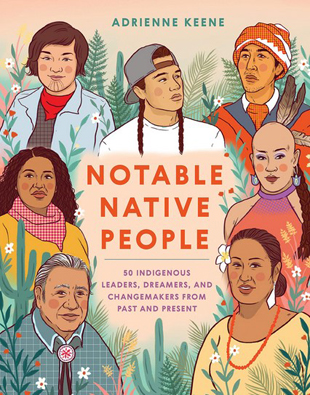This book begins right where it ought to, with this in the Introduction: “The lands in what is currently known as the United States encompass the homelands of 574 federally recognized American Indian tribal nations, as well as hundreds more state-recognized and non-recognized tribal nations. In addition, through later acts of land seizing — and in the case of the Hawaiian Kingdom, illegal overthrow — our extended Indigenous community also includes Kanaka Maoli and Alaska Native people.”
It is these groups that are the sources for the people profiled here. It’s possible that none of the names will already be familiar to you, and that is why the book is important. We hope that every public library in the United States will purchase a copy.
Jessie Little Doe Baird, born 1963, is a citizen of the Mashpee Wampanoag nation, the people who met the Mayflower in 1620. She is a linguist and language revitalization advocate, a MacArthur Foundation “Genius Grant” recipient, seeking to revive the language of the Wampanoag people.
Rowen White, born 1979, is a member of the Akwesasne Mohawk community, with a passion for what is called “seed sovereignty” — the right of communities to control and protect their seeds. As author Adrienne Keene explains, it was while a student at Hampshire College that White “began to see seeds as relatives and connections to our ancestors.” Seed sovereignty is particularly important to Indigenous people because “many crops that Native people carefully cultivated and relied upon for centuries were lost or nearly lost during colonization, when settlers purposefully destroyed Indigenous food systems.”
These are simply the first two profiles. There are 48 more. Most are of living Indigenous people, the youngest born in 1992: Kyrie Irving, a famous NBA basketball player whose mother was Lakota, born on the Standing Rock Reservation, but was adopted out of the Indigenous community. She died when Irving was only four. Keene tells us, “In 2018, the tribe hosted a 'welcome home' ceremony for Kyrie and his older sister.”
The other well-known contemporary figure in the book was born in 1980: Sharice Davids, of the Ho-Chunk people, who is now the youngest Indigenous member of Congress.
Short articles on key topics ideally suited to learning more are sprinkled throughout the book. These are “Settler Colonialism 101,” “Whose Land Are You On?,” “Representation Matters,” “Hawai’i and Alaska,” “Current Issues in Indian Country,” and “Who Belongs?” — which begins, “To be an Indigenous person means to have ties to a physical place and a people. It is a complex identity to hold, one that doesn’t fit easily into the categories of race, citizenship, and heritage set up by the American system.”
Eighteen of the profiles are of people from centuries past, beginning with Po’Pay, ca. 1630-1688, the medicine man and Pueblo revolt leader, and including Ka’ahumanu, co-leader of the Hawaiian Kingdom, who lived from 1768-1832, and whose “legacy as a powerful female ruler is recognized today in Hawai’i through the Ka’ahumanu Society, a civic club that celebrates Hawaiian culture and looks after elders.”
Author Adrienne Keene is a scholar and writer of the Cherokee Nation. Illustrator Ciara Sana’s art is imbued with the spirit of her Indigenous Chamoru culture.
